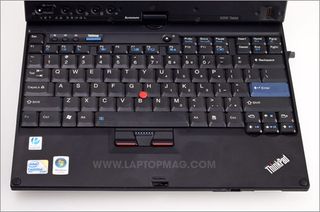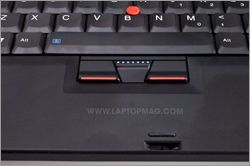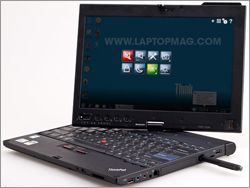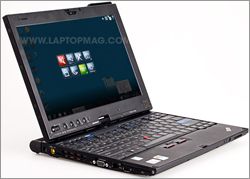Laptop Mag Verdict
Not only does this convertible have an excellent touchscreen, but its performance and battery life are stellar.
Pros
- +
Strong touch performance
- +
Excellent keyboard
- +
Long battery life
- +
Lightweight design
Cons
- -
No touchpad or optical drive
- -
Somewhat bulky
Why you can trust Laptop Mag
We've long been fans of Lenovo's ThinkPad X200 Series of exceptional ultraportables, having given high marks to the original X200, the low-voltage X200s, and the X200 Tablet. Now, more than a year after introducing the original X200 Tablet, Lenovo has added an optional multitouch screen that takes an already best-in-class business convertible to the next level by offering very good Windows 7 performance and seven hours of battery life.
Design
The first thing you'll notice about the X200 Tablet is its small size and light weight. At 11.6 x 10.1 x 1.3 inches, the notebook is a little bigger than the 12-inch Dell Latitude XT2 (11.7 x 8.7 x 1.1 inches). According to Lenovo, the X200 Tablet (with a four-cell battery) weighs a netbook-like 3.5 pounds, but our review unit came with the eight-cell option (which protrudes out the back) and weighs in at 4.2 pounds. The X200 Tablet is nearly half a pound heavier than the Latitude XT2, but that system has a smaller six-cell battery.
Like all other ThinkPads, the X200 Tablet features a matte black chassis, green indicator lights, and a bright red trackpoint. Above the keyboard are keys for raising, lowering, and muting audio, and the familiar ThinkVantage button, which launches Lenovo utilities for managing power, wireless, and other settings. Below the lower edge of the screen are a finger print reader, a switch for locking the operating system, a power button, and buttons for rotating the display, hitting Ctrl + Alt + Delete, and pulling up the ThinkVantage tools menu.
Keyboard and Touchpad

Click to enlarge

Click to enlargeThe X200 Tablet sports a full-size, spill-resistant keyboard, which has the comfortable, tried-and-true ThinkPad design. The keys offer fantastic tactile feedback, and we were able to achieve a strong 80 words per minute and 2 percent error rate in Ten Thumbs Typing Tutor. However, those with larger hands may find the short wrist rest to be a minor discomfort.
As with the ThinkPad X200, Lenovo eschews its usual trackpoint-and-touchpad combination in favor of only a trackpoint to streamline the system. That may seem like an odd choice to some, but veteran ThinkPad users and novices should have no problems navigating the 12.1-inch display with just the stick.
Display and Touchscreen Performance
The X200 Tablet's 1280 x 800-pixel resolution screen can swivel either right or left to convert into tablet mode, which is particularly helpful for lefties. The screen is incredibly bright, and viewing angles are strong even from 90 degrees to the left or right.
The screen recognizes both finger and stylus input. After some calibrating and increasing the sensitivity settings, we were impressed with the quality and responsiveness of the touch experience; using the stylus, we were able to easily navigate through the Start menu, tap on icons, and drag windows around.

Click to enlargeEven better, we were able to use Window 7's built-in handwriting recognition tool, which automatically appears as a floating widget above your apps, to write text into Microsoft Word 2007 by hand. We were simply amazed at how accurate the program was (in light of our terrible handwriting). The X200 Tablet even got a little more accurate as we used it, since it is supposed to learn from user input. Even when the system mistook our chicken scratch, we were able to easily highlight a word and replace the incorrect letter with the right one.
The new multitouch screen, a $200 option, uses a high-quality capacitive touch digitizer to register input from two fingers at once, allowing users to perform such multitouch gestures as pinching to zoom or swiping two fingers to scroll. In testing, the screen was highly responsive, and only a light touch was required for it to register. However, we had to be careful to use the pads at the end of our fingers, as the screen did not always recognize presses with our nails.
Using the tips of our fingers, we were able to take advantage of Windows 7's built-in touch features, including opening Jump Lists by swiping upward on taskbar icons, scrolling in Internet Explorer by swiping up or down, rotating pictures by turning our fingers, and zooming in/out on images and Web pages by pinching.
While we wish that Microsoft or Lenovo had done something to make the Start menu shortcuts or system widgets like the window-close button get bigger when you use your finger, we found it easier to target icons and buttons on the X200 Tablet's 1280 x 800-pixel screen than on the T400s' higher resolution 1440 x 900 screen.
Of course, any Windows 7 application, even those written with no touch support, can accept touches in lieu of mouse gestures. For example, we were able to navigate around a spreadsheet in Excel 2007 using touch, even though the individual cells were hard to target. Windows Paint is one application that works very well with multitouch, as it allows you to draw with several fingers at once. However, the X200 Tablet limits you to two fingers, while the T400s allows for more than four.
In addition to the built-in handwriting recognition application for stylus users, Windows 7 provides a touchscreen keyboard you can use to type on the screen. This comes in particularly handy when the system is in portrait mode and the physical keyboard and trackpoint are unavailable.
Touch Applications

Click to enlarge
Complimenting Windows 7's built-in touch functions is Lenovo's SimpleTap utility, which is designed to give users touch access to many ThinkVantage utilities. Double-tapping two fingers on the desktop or one finger on a launch icon (a red ball that hangs from the top of the desktop) brings up the interface, which has tiles for brightness control, camera control, the keyboard light, locking the system, microphone on/off, sleep, volume control, and Wi-Fi on/off.
You can add custom tiles for any application, making the SimpleTap interface a potential Start menu substitute. We also like that you can add shortcuts to your favorite sites as tiles (SimpleTap automatically pulled in Laptopmag.com's logo for the tile). In addition to tapping the tiles to launch each associated application, you can move them around the screen. When dragged, they even bounce off the edges of the display, a neat but impractical special effect.
Our system also came with Windows 7 Touch Pack preinstalled, which includes a few touch games (Microsoft Blackboard, Garden Pond, and Rebound), a touchscreen saver called Surface Lagoon, and Surface Collage, a gallery program. While none of these apps are particularly useful, they are great demonstrations of what multitouch can do; we enjoyed being able to make puddles in the screen saver's water by tapping the screen. As with the Paint program, we could only use two fingers, while the T400s with touch let us make puddles with more than four fingers.
Aside from using SimpleTap, taking advantage of Windows 7's built-in touch features, or using it on touch-unaware programs such as Word, you're left to download and install your own touch-friendly apps. Unfortunately, there aren't many outstanding multitouch apps for Windows right now, unless you're in a niche market that involves 3D modeling or medical imaging. If you are, then you'll appreciate the ability to run programs such as SpaceClaim, a multitouch modeling program that Lenovo points to as an example of the capabilities of the platform.
Multimedia Performance
The video quality on the X200 Tablet's screen was impressive. Colors were bright and vibrant, and darks were true when we downloaded both 720p and 1080p clips from Microsoft's MWV HD Content Showcase. However, the poor quality of the speakers means that you'll want to attach a pair of headphones or external speakers. After 30 seconds of listening to Twisted Sister's "We're Not Gonna Take It" streaming from Napster, we simply couldn't take it anymore; the sound was loud but painfully tinny and distorted.
Ports and Webcam
The perimeter of the X200 Tablet features three USB 2.0 ports, VGA, 5-in-1 memory card reader, ExpressCard/34/54, Ethernet, modem, and headphone/mic jacks, and the left side of the machine has a switch for toggling Wi-Fi on and off. The system lacks an optical drive, so if you want to watch Blu-ray discs or DVDs, you'll have to invest in an external drive.

Click to enlarge

Click to enlarge
The 1.3-megapixel webcam captured incredibly sharp and detailed images, even in low light. When making a Skype call, our friend was able to see a bright, smooth image of our face and waving hand, even as we sat in a half-darkened room.
CPU and GPU Performance
The combination of a 2.13-GHz Intel Core 2 Duo CPU, 4GB of RAM, and a 7,200-rpm hard drive on our X200 Tablet allowed it to notch a strong score of 3,473 on PCMark Vantage, which measures overall system performance. This score was more than 700 points above the ultraportable category average (2,738), and easily eclipsed the original X200 Tablet (3,012) we reviewed last year. It also matched the powerful Fujitsu LifeBook T5010 (3,472). The Dell Latitude XT2, which costs about $300 more, only managed 2,887 on the same test. However, that system has a lower-power 1.4-GHz Intel Core 2 Duo SU9400 CPU, and 3GB of RAM.
The speedy 7,200-rpm, 320GB Hitachi hard drive booted Windows 7 Professional in just 40 seconds, a full 21 seconds faster than the category average of 61 seconds. It also completed the LAPTOP Transfer Test, in which we copy 4.97GB of mixed media, in a speedy 3 minutes and 13 seconds, for a rate of 26.4 MBps--well above the category average of 19.5 MBps and ahead of the original ThinkPad X200 Tablet (16.5 MBps) and Fujitsu LifeBook T5010 (15.5 MBps). However, this showing is well below the 38.0 MBps transfer rate turned in by the 128GB Intel SSD inside the Dell XT2.
The X200 Tablet completed our video transcoding test, in which we convert a 5-minute-and-5-second MPEG-4 to AVI using HandBrake, in a speedy 7 minutes and 32 seconds, which was more than twice as fast as the category average of 15:18.
While it's fine for playing video and performing most business tasks, the X200 Tablet is not meant to be a gaming machine. In 3DMark06, which measures graphics performance, the X200 Tablet's integrated Intel GMA 4500MHD graphics chip delivered a score of 1,071, which is about 20 percent above the ultraportable category average of 830 and the 805 returned by the original X200 Tablet. It was also on a par with the 1,002 scored by the Fujitsu LifeBook T5010.
Set to 1024 x 768-pixel resolution, the X200 Tablet mustered a glacial 6 frames per second in Far Cry 2, and it was even worse (3 fps) at its native resolution of 1280 x 800. Both scores were in line with the ultraportable category averages of 6 and 4 fps, respectively.
Battery Life and Wi-Fi
The X200 Tablet with multitouch lasted 7 hours on the LAPTOP Battery Test, which involves continuous Web surfing over Wi-Fi. This time was 2 hours above the 4:40 category average, and well ahead of the 5:54 provided by the original X200 Tablet. In addition, this time was double that of the Dell Latitude XT2 (3:25), which, to be fair, has a smaller six-cell battery. Regardless, notebooks this portable should be able to last at least 4 hours.
The X200 Tablet's Intel WiFi Link 5100AGN wireless card delivered reasonable transfer rates of 19.7 and 18.5 Mbps from 15 and 50 feet, respectively. These were slightly better than the category averages of 19.4 and 16.7 Mbps, and about even with the original X200 Tablet (19.5 and 18.1 Mbps) and the Fujitsu LifeBook T5010 (20.7 and 18.0 Mbps).
Configuration Options

Click to enlarge
Our configuration of X200 Tablet costs $2,075, but you can economize by opting for a slower processor, 1GB instead of 4GB of RAM, and a smaller hard drive. You can also splurge by getting integrated mobile broadband from AT&T or Verizon Wireless for $80 to $125, or by upgrading to a 128GB SSD for $380.. Whatever you do, splurge for the larger $50.00 eight-cell battery option .
If using the system outdoors matters to you more than using multitouch, a similarly configured X200 Tablet with a SuperBright outdoor screen can be had for $2,125. We previosly tested a unit with the SuperBright screen, and were blown away by the brilliance of the colors. It also got a very strong 6 hours and 27 minutes of runtime--just a half hour less than with the multitouch display.
Verdict
Adding multitouch, Windows 7, and faster processor options to the original ThinkPad X200 Tablet makes this system even more compelling than before, and its $2,075 price makes it even more of a bargain. While it's a bit bulkier than the Dell Latitude XT2, the extra mass is a worthy compromise given this ThinkPad's longer battery life, better performance, and lower price tag. We can imagine executives, physicians, and other mobile professionals walking around with their X200 Tablets in portrait mode, and using the incredible handwriting recognition and enticing multitouch gestures to take notes, surf the Web, and work on important projects.
Lenovo ThinkPad X200 Tablet Specs
| Bluetooth | Bluetooth 2.0+EDR |
| Brand | Lenovo |
| CPU | 1.86-GHz Intel Core 2 Duo L9400 |
| Card Slots | 5-1 card reader, ExpressCard |
| Company Website | http://www.lenovo.com/us |
| Display Size | 12.1 |
| Graphics Card | Intel GMA 4500M HD |
| Hard Drive Size | 160GB |
| Hard Drive Speed | 7,200rpm |
| Hard Drive Type | SATA Hard Drive |
| Native Resolution | 1280x800 |
| Operating System | MS Windows Vista Business |
| Ports (excluding USB) | VGA, Modem, Microphone, Headphone, Ethernet |
| RAM | 2GB |
| RAM Upgradable to | 4GB |
| Size | 11.6 x 10.1 x 1.3 inches |
| USB Ports | 3 |
| Video Memory | 384MB |
| Warranty/Support | One-year standard/24/7 toll-free phone |
| Weight | 4.2 pounds |
| Wi-Fi | 802.11a/b/g/n |

